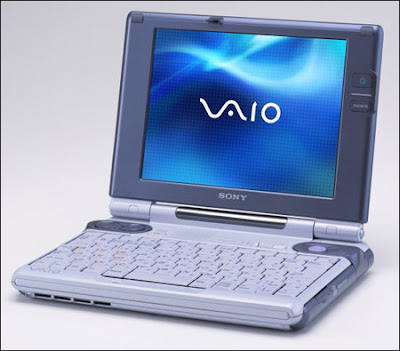
Sony were the first to introduce a Crusoe based subnotebook and this time around they are the first to introduce a palm-top ultra subnotebook (what we are calling the PCG-U1 around here). The PCG-U1 is powered by a TM5800 Crusoe processor running at 867MHz and sports up to four hours of battery life in a package the measures less than 185mm wide. The XGA screen on this little guy is 6.4" in size and supports a resolution of 1024×768 pixels. The ultra subnotebook weighs just 820 grams.
The TM5800 is Transmeta's newest Crusoe processor which comes equipped with 128 Kb of L1 and 512KB of L2 cache. The chip is based on the 0.13 micron process and is expected to eventually scale to 1.0GHz. Equipped with 128MB of SDRAM, and expandable to 256MB, the PCG-U1 also comes with a 20GB ATA100 harddrive. All other media drives are external, connecting via USB, or port replicators, except for a Sony memory stick port.
With Windows XP home edition loaded on to the small 20GB hard drive, and room for proprietory Sony Memory sticks on the side the PCG-U1 at least features an RJ45 network adaptor, twin USB ports, and Firewire jack for large data transfers. One Type II PCMCIA port is integrated with in the ultra sub notebook, and larger batteries can be clipped on to the bottom to boost the average 2 hour lifespan to 4 hours.
At the moment the Sony VIAO PCG-U1 is only available in Japan, and is like to remain that way for some time to come. The small form factor that the Japanese love so much is often difficult for western individuals to use because hand sizes tend to be larger. The U1 is an interesting step to take a notebook computer - sort of a glorified PDA with notebook qualities, but it remains to be see what real market share devices like this will be able to capture. With cellphones, PDA's and now notebooks converging on the same features it is getting difficult to tell the lines between ultra portable and ultra superfluous application duplication.... after all if your cell phone can now open word documents, and your PDA can send email, should the notebook become a cellphone... only Confucius can really tell for sure.
The TM5800 is Transmeta's newest Crusoe processor which comes equipped with 128 Kb of L1 and 512KB of L2 cache. The chip is based on the 0.13 micron process and is expected to eventually scale to 1.0GHz. Equipped with 128MB of SDRAM, and expandable to 256MB, the PCG-U1 also comes with a 20GB ATA100 harddrive. All other media drives are external, connecting via USB, or port replicators, except for a Sony memory stick port.
With Windows XP home edition loaded on to the small 20GB hard drive, and room for proprietory Sony Memory sticks on the side the PCG-U1 at least features an RJ45 network adaptor, twin USB ports, and Firewire jack for large data transfers. One Type II PCMCIA port is integrated with in the ultra sub notebook, and larger batteries can be clipped on to the bottom to boost the average 2 hour lifespan to 4 hours.
At the moment the Sony VIAO PCG-U1 is only available in Japan, and is like to remain that way for some time to come. The small form factor that the Japanese love so much is often difficult for western individuals to use because hand sizes tend to be larger. The U1 is an interesting step to take a notebook computer - sort of a glorified PDA with notebook qualities, but it remains to be see what real market share devices like this will be able to capture. With cellphones, PDA's and now notebooks converging on the same features it is getting difficult to tell the lines between ultra portable and ultra superfluous application duplication.... after all if your cell phone can now open word documents, and your PDA can send email, should the notebook become a cellphone... only Confucius can really tell for sure.












